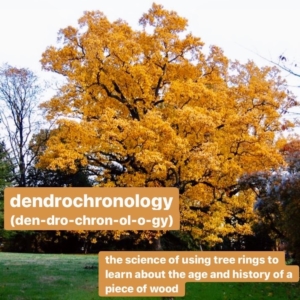Lesson: What Trees Can Tell Us

Trees gain one ring per year, like candles on a birthday cake. In this activity, students use tree rings to tell the story of a tree and its environment. Download the lesson plan and answer key here. Fit for elementary education.
Subjects: Plant science, natural science, simply math, historic preservation
Materials: Worksheet, glossary, and answer key (download) & pencil
Time: 25 minutes
Abilities: 5th grade reading level; basic counting and math; making comparison statements
Introduction:
Dendrochronology is the science of using tree rings to learn about the age and history of a piece of wood. Say the word out loud:
“ den-dro-chron-ol-o-gy ”
Dendrochronology is not only used for trees. Dendrochronology helps people learn about wooden buildings. Tree rings can also tell historians about the climate from long ago.
At Tudor Place, scientists took samples of wood from parts of the old house. The scientists used dendrochronology to learn what year the wood was cut down from a tree. They can’t know exactly, but they can make a good guess. The scientists discovered that parts of the building were older than we had thought. We can learn history through trees!
Learn how to read tree rings. Then find out what trees can tell us!





